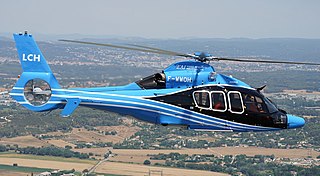
The HFB 320 Hansa Jet is a twin-engine, ten-seat business jet that was designed and produced by German aircraft manufacturer Hamburger Flugzeugbau between 1964 and 1973. The most recognisable and unconventional feature of the aircraft is its forward-swept wing.

The NAL Saras is the first Indian multi-purpose civilian aircraft in the light transport aircraft category as designed by the National Aerospace Laboratories (NAL).

The HAL HJT-36 Sitara is a subsonic intermediate jet trainer aircraft designed and developed by Aircraft Research and Design Centre (ARDC) and built by Hindustan Aeronautics Limited (HAL) for the Indian Air Force and the Indian Navy. The HJT-36 will replace the HAL HJT-16 Kiran as the Stage-2 trainer for the two forces.

The British Aerospace EAP is a British technology demonstrator aircraft developed by aviation company British Aerospace (BAe) as a private venture. It was designed to research technologies to be used for a future European combat aircraft, and for the multinational Eurofighter Typhoon.

The National Aerospace Laboratories (NAL) is India's first and largest aerospace research company established by the Council of Scientific and Industrial Research (CSIR) in Delhi in 1959. The company closely operates with HAL, DRDO, and ISRO and has the primary responsibility of developing civilian aircraft in India. It concentrates on research in advanced topics in aerospace and related disciplines.

The Dornier 228 is a twin-turboprop STOL utility aircraft, designed and first manufactured by Dornier GmbH from 1981 until 1998. Two hundred and forty-five were built in Oberpfaffenhofen, Germany. In 1983, Hindustan Aeronautics Limited (HAL) bought a production licence and manufactured another 125 aircraft in Kanpur, Uttar Pradesh, India. In July 2017, 63 aircraft were still in airline service.

The Let L-410 Turbolet is a twin-engine short-range transport aircraft designed and produced by the Czech aircraft manufacturer Let Kunovice.

The Diamond DV20/DA20 Katana is an Austrian-designed two-seat general aviation light aircraft. Developed and manufactured by Diamond Aircraft, it was originally produced in Austria as the DV20.

The Novi Avion was a fourth generation multi-role combat aircraft programme that was to be built by Yugoslav aircraft manufacturer SOKO.

The Flight Design CT series is a family of high-wing, tricycle undercarriage, two seat, ultralight and light-sport aircraft produced by Flight Design of Germany. The family includes the original CT and the CT2K, CTSW, CTLS and the MC models.
Costruzioni Aeronautiche TECNAM S.p.A., commonly known as simply Tecnam, is an Italian aircraft manufacturer. The company has two primary activities: producing aircraft components for various other manufacturers, and manufacturing its own range of light aircraft. The company was founded in 1986 by Italian brothers Luigi Pascale and Giovanni Pascale, veteran aircraft designers and manufacturers. Prior to creating Tecnam, they had been responsible for several other aviation-related projects, including the design and construction of the twin-engine Partenavia P.68. Their original intent in founding Tecnam was to build aerospace parts on behalf of other manufacturers, which initially included American aerospace company Boeing and commuter airliner specialist ATR. When the light-sport aircraft market began to emerge, the brothers entered the field, first with the Tecnam P92, which was well received.

The SportStar and EuroStar are a family of a two-seat, light sport aircraft (LSA), manufactured by Evektor-Aerotechnik of Czechia and powered by a Rotax 912ULS 100 horsepower (75 kW) engine.

The Grob G180 SPn is a low-wing twin-engined composite corporate jet designed and built by German aircraft manufacturer Grob Aerospace. Development was suspended during 2008 in response to the Grob's insolvency; since then, multiple efforts have been made to re-launch the programme. Tata Advanced Systems Limited (TASL) has bought the Intellectual Property rights of the aircraft and will manufacture it in India.

NM5 or C-NM5 was an indian multi-role, multi-mission aircraft being jointly developed by National Aerospace Laboratories (NAL) and Mahindra Aerospace. It is a 5-seater civil aircraft and an extension of the Hansa project. The NM5 was entirely designed and developed by NAL and Mahindra Aerospace on a 50:50 partnership basis. The NM5 can be used as a trainer, for transporting cargo, medical evacuation, tourism, VIP travel and for training pilots.

The KAI KC-100 Naraon is a South Korean four-seat, low-wing, single-engine light aircraft developed and manufactured by Korea Aerospace Industries (KAI). The name Naraon was chosen based on public input. It has the distinction of being the first civil-orientated aircraft to be developed in South Korea.

The Peak Aerospace Me 109R is a family of German replica warbird ultralight aircraft that was designed by Tassilo Bek, and originally produced by Peak Aerospace of Pasewalk. The company since changed its name to Classic Planes GmbH. The design, first flown in 1991, is an 80% scale replica of the Second World War Messerschmitt Bf 109 and is supplied as a kit for amateur construction or as a complete ready-to-fly-aircraft.

Flaris LAR01, also variously called the LAR 1 and LAR-1, is a Polish five-seat very light jet, currently under development by Metal-Master of Jelenia Góra. It is the only single-engined very light jet currently being developed by a non-American aircraft manufacturer.

The Aero L-39NG is a turbofan-powered military trainer and light combat aircraft developed and produced by the Czech aircraft manufacturer Aero Vodochody. It is a successor of the Cold War era Aero L-39 Albatros.

The CFM Air Dardo is an Italian ultralight aircraft that was designed by CFM Air of Cirié, introduced at the AERO Friedrichshafen show in 2014.

The KAI LCH is a medium-sized twin-engined civil helicopter manufactured by the South Korean aerospace manufacturer Korea Aerospace Industries (KAI). It is derived from the Eurocopter EC155 and is closely related to the Light Armed Helicopter (LAH), a militarised rotorcraft intended for battlefield operations.
























